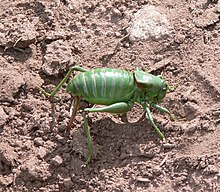| Mormon cricket | |
|---|---|

| |
| Scientific classification | |
| Domain: | Eukaryota |
| Kingdom: | Animalia |
| Phylum: | Arthropoda |
| Class: | Insecta |
| Order: | Orthoptera |
| Suborder: | Ensifera |
| Family: | Tettigoniidae |
| Genus: | Anabrus |
| Species: | A. simplex
|
| Binomial name | |
| Anabrus simplex Haldeman, 1852
| |

The Mormon cricket (Anabrus simplex) is a large insect native to western North America in rangelands dominated by sagebrush and forbs. Anabrus is a genus in the shield-backed katydid subfamily in the Tettigoniidae family, commonly called katydids, bush crickets, and previously "long-horned grasshoppers." Its common name, "Mormon cricket," is a misnomer: true crickets are of the family Gryllidae.
The Mormon cricket takes its common name from the prominent role it played in the miracle of the gulls after the Mormon settlers in Utah had encountered them while pushing westward.[2]
Although flightless, the Mormon cricket may travel up to two kilometres a day in its swarming phase[3] during which it may be a serious agricultural pest and sometimes a traffic hazard.
- ^ "NatureServe Explorer 2.0".
- ^ Hartley, William (Summer 1970). "Mormons, Crickets, and Gulls: A New Look at an Old Story". Utah Historical Quarterly. 38 (3): 224–239. doi:10.2307/45058907. JSTOR 45058907. S2CID 254430829.
- ^ Lorch, Patrick D.; Sword, Gregory A.; Gwynne, Darryl T.; Anderson, Gerald L. (October 1, 2005). "Radiotelemetry reveals differences in individual movement patterns between outbreak and non-outbreak Mormon cricket populations" (PDF). Ecological Entomology. 30 (5): 548–555. doi:10.1111/j.0307-6946.2005.00725.x. S2CID 53489161. Retrieved March 31, 2013.
